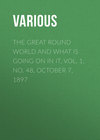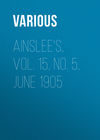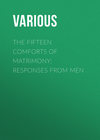Читать книгу: «Lippincott's Magazine of Popular Literature and Science, Vol. XVI., December, 1880.», страница 5
Boston has other churches which, like the Park Street, are neither ancient nor modern, the Hollis Street Church and the First Church in Roxbury being good examples. New England has hardly a better specimen of the old-fashioned meeting-house on a hill than this old weather-beaten wooden First Church in Roxbury, the home of a parish to which John Eliot, the apostle to the Indians, once ministered. Another quaint memorial of the old colonial days survives in the current name, "Meeting-house Hill," of a part of the annexed Dorchester district of Boston.
St. Paul's Church, on Boston Common, was the first attempt of the Episcopalians of the city, after the loss of King's Chapel, to build a temple of imposing appearance. Controversies theological and architectural rose with its walls, and young Edward Everett, if report is to be credited, was the author of a tract, still in circulation, in which its design and its principles formed the text for a criticism on the religion to whose furtherance it was devoted. Standing as it does next the United States court-house, the uses of the two buildings seem to have been confused in the builders' minds; for there is something ecclesiastical in the appearance of the hall of justice, which was originally a Masonic temple, and something judicial in the face of the church.
In Cambridge, three miles from Boston, the eighteenth-century Episcopalians not only possessed a church, but also displayed to unwilling eyes a veritable "Bishop's Palace"—the stately house of the Rev. East Apthorp, "missionary to New England" and reputed candidate for the bishopric of that region. Mr. Apthorp was rich and influential, but his social and ecclesiastical lot was not an easy one, and he soon returned to England discouraged, leaving his "palace" to come down to the view of our own eyes, which find in it nothing more dangerous to republican institutions than is to be discovered in a hundred other of the three-story wooden houses which used so to abound in Massachusetts. Christ Church, Cambridge, in which the bishop in posse used to minister, and which stands opposite Harvard College, was designed by the architect of King's Chapel, and has always been praised for a certain shapely beauty of proportion. For the last twenty years it has boasted the only chime of bells in Cambridge, whose quiet shades of a Sunday evening have been sweetly stirred by the music struck from them by the hands of a worthy successor of the mediæval bell-ringers, to whom bells are books, and who can tell the story of every ounce of bell-metal within twenty miles of his tower. It was of this church, with its Unitarian neighbor just across the ancient churchyard where so many old Harvard and colonial worthies sleep, that Holmes wrote:
Like sentinel and nun, they keep
Their vigil on the green:
One seems to guard, and one to weep,
The dead that lie between.
The suburbs of Boston are not poor in churches of the eighteenth, or even of the seventeenth, century. The oldest church in New England—the oldest, indeed, in the Northern States—still standing in Salem, was built in 1634, and its low walls and tiny-paned windows have shaken under the eloquence of Roger Williams. It has not been used for religious purposes since 1672. In Newburyport is one of the American churches, once many but now few, in which George Whitefield preached, and beneath it the great preacher lies buried. A curious little reminder of St. Paul's, London, is found here in the shape of a whispering gallery. Another landmark is the venerable meeting-house of the Unitarian society in Hingham, popularly known as the "Old Ship." Built in 1681, it was a Congregational place of worship for nearly a century and a half. Its sturdiness and rude beauty form a striking illustration of the lasting quality of good, sound wooden beams as material for the sanctuary. Preparations have already been undertaken for celebrating the second centennial of the ancient building. Nearly as old, and still more picturesque with its quaint roof, its venerable hanging chandelier of brass, its sober old reredos and its age-hallowed communion-service, is St. Michael's, Marblehead, built in 1714, where faithful rectors have endeavored to reach six generations of the fishermen and aristocracy of the rocky old port. The antiquarian who has seen these old temples and asks for others on the New England coast will turn with scarcely less interest to St. John's, Portsmouth; the forsaken Trinity Church, Wickford, Rhode Island, built in 1706; or Trinity, Newport, where Bishop Berkeley used to preach. In Newport, indeed, one may also speculate beneath the Old Mill on the fanciful theory that the curious little structure was a baptistery long before the days of Columbus—the most ancient Christian temple on this side the sea.
It is not uncommon to find comparatively new American churches to which their surroundings or their sober material or their quiet architecture have given a somewhat exaggerated appearance of age. Such is the case with the curious row of three churches—the North and Centre Congregational and Trinity Episcopalstanding side by side on the New Haven green in a fashion unknown elsewhere in our own country. Any one of these three churches looks quite as old as that shapely memorial of pre-Revolutionary days, St. Paul's Chapel, New York, built in 1766 in the prevailing fashion of the London churches. As with St. Paul's, there was also no marked appearance of antiquity in the North Dutch Church, New York, removed in recent years. The poor old Middle Dutch Church in the same city, with its ignoble modern additions and its swarm of busy tenants, would have looked old if it could have done so, but for modern New Yorkers it has no more venerable memory, in its disfigurement and disguise, than that furnished by its use, for a time, as the city post-office.
New York is poor in old buildings, and especially poor in old churches. Besides St. Paul's, the comparatively modern St. John's Chapel and the John Street Methodist Church, it really has nothing to show to the tourist in search of ancient places of worship. The vicinity can boast a few colonial temples—the quaint old Dutch church at Tarrytown, dear to the readers of Irving; the Tennent Church on the battle-ground of Monmouth, New Jersey, with its blood-stains of wounded British soldiers; and a charmingly plain little Friends' meeting-house, no bigger than a small parlor, near Squan, New Jersey, being the most strikingly attractive. In Newark one notes the deep-set windows and solid stone walls of the old First Presbyterian Church, and the quiet plainness of Trinity Episcopal Church, which looks like Boston's King's Chapel, with the addition of a white wooden spire.
Philadelphia is richer than any other American city in buildings of the seventeenth and eighteenth centuries. On the older streets it is a frequent sight to see quaint little houses of imported English brick modestly laid in alternate red and black, curiously like the latest modern fashion. The ample room for growth possessed by this widespreading city has saved many an ancient house for present use as dwelling or store. One is not surprised, therefore, to find on the old streets near the Delaware three churches of weather-stained brick which seem trying to make the piety of an elder age useful to the worshippers of to-day. All three of these churches—Gloria Dei, Christ and St. Peter's—now have their chief work among the poor people whom one always finds in a business quarter near the river-front, but each attracts, by its old-time associations and its modern missionary spirit, a goodly circle of attendants from the western parts of the city. Gloria Dei Church, the oldest of the three, was built in 1700 by Swedish Lutherans on the spot where the Swedish predecessors of the Friends had located their fortified log church twenty-three years earlier. Its bell and communion-service and some of its ornamental woodwork were presented by the king of Sweden. It is surrounded by the usual graveyard, in which lies Alexander Wilson, the lover and biographer of birds, who asked to be buried here, in a "silent, shady place, where the birds will be apt to come and sing over my grave." The Old Swedes' Church retained its Lutheran connection until recent years, when it became an Episcopal parish.
Christ Church and St. Peter's were formerly united in one parochial government, and to the two parishes ministered William White, the first Church-of-England minister in Pennsylvania, the friend and pastor of Washington, the chaplain of Congress and one of the first two bishops of the American Church. The present structure of Christ Church was begun in 1727, but not finished for some years. The parish is older, dating from 1695. Queen Anne gave it a communion-service in 1708. In 1754 came from England its still-used chime of bells, which were laboriously transferred during the Revolution to Allentown, Pennsylvania, lest they should fall into British hands and be melted up for cannon. At Christ Church a pew was regularly occupied by Washington during his frequent residence in Philadelphia; and here have been seated Patrick Henry, Benjamin Franklin, James Madison and many another patriot, besides Cornwallis, Howe, André and others on the English side. Around and beneath the church are many graves covered by weather-worn stones, and on the walls of the interior there are a number of mural tablets.
St. Peter's Church was begun in 1758, and completed three years later. In quiet graciousness of appearance it is like another Christ Church, and its interior arrangements are still more quaint, the chancel being at the eastern end of the church, while the pulpit and lectern are at the western. In the adjoining churchyard is a monument to Commodore Decatur.
One cannot find in all America sweeter and quainter memorials of a gentle past—memorials still consecrated to the gracious work of the present—than the churches and other denominational houses in the old Moravian towns of Pennsylvania. At Bethlehem, as one stands in the little three-sided court on Church street and looks up at the heavy walls, the tiny dormer windows and the odd-shaped belfry which mark the "Single Sisters' House" and its wings, one may well fancy one's self, as a travelled visitor has said, in Quebec or Upper Austria. Still more quaint and quiet is Willow Square, behind this curious house, where, beneath drooping willow-boughs, one finds one's self beside the door of the old German chapel, with the little dead-house, the boys' school and the great and comparatively modern Moravian church near by. Through Willow Square leads the path to the burying-ground, where lie, beneath tall trees, long rows of neatly-kept graves, each covered with a plain flat stone, the men and the women lying on either side of the broad central path. Several of the ancient Moravian buildings date from the middle of the last century. The Widows' House stands, opposite the Single Sisters' Range, and across the street from the large church is the Moravian Seminary for Young Ladies, established in 1749, and by far the oldest girls' school in the United States.
It was in 1778 that the Single Sisters gave to Pulaski that banner of crimson, silk which is commemorated in Longfellow's well-known "Hymn of the Moravian Nuns at Bethlehem." The poem, however, written in the author's early youth, and preserved for its rare beauty of language and fine choice of subject, rather than for its historical accuracy, has done much to perpetuate a wrong idea of the Moravian spirit and ritual. Mr. Longfellow writes in his first stanza
When the dying flame of day
Through the chancel shot its ray,
Far the glimmering tapers shed
Faint light on the cowled head,
And the censer burning swung,
When before the altar hung
That proud banner, which, with care,
Had been consecrated there;
And the nuns' sweet hymn was heard the while,
Sung low in the dim, mysterious aisle.
But the Moravians know nothing of chancels, tapers, cowled heads, censers, altars or nuns. Their faith has always been the simplest Protestantism, their churches are precisely such as Methodists or Baptists use, and their ritual is plainer than that of the most "evangelical" Episcopal parish. Their "single sisters' houses," "widows' houses" and "single brethren's houses"—the last long disused—are simply arrangements for social convenience or co-operative housekeeping. Mr. Longfellow's poetic description applies to the Moravian ceremonial no more accurately than to a Congregational prayer-meeting or a Methodist "love-feast."
Beside the deep and silent waters of the James River in Virginia, undisturbed by any sound save the flight of birds and the rustle of leaves, stands all that is left of the first church building erected by Englishmen in America. A good part of the tower remains, the arched doorways being still intact, and it seems a pitiable misfortune that the honestly-laid bricks of the venerable building could not have come down to our day. But, as it is, this ancient square block of brick forms our one pre-eminent American ruin. Nothing could be a more solemn monument of the past than the lonely tower, surrounded by thick branches and underbrush and looking down upon the few crumbling gravestones still left at its base. Jamestown, long abandoned as a village, has now become an island, the action of the waters having at last denied it the remaining solace of connection with the mainland of the Old Dominion, of whose broad acres it was once the chief town and the seat of government—the forerunner of all that came to America at the hands of English settlers.
In the slumberous old city of Williamsburg, three miles from Jamestown, stands the Bruton parish church, two hundred and two years old, and still the home of a parish of sixty communicants. Built of brick, with small-paned windows and wooden tower, its walls have listened to the eloquence of the learned presidents of the neighboring William and Mary College, and its floor has been honored by the stately tread of many a colonial governor, member of the legislature or Revolutionary patriot; for Williamsburg was the capital and centre of Virginia until the end of the eighteenth century, and shared whatever Virginia possessed of political or personal renown. Washington, of course, was more than once an attendant at Bruton Church, and so were Jefferson and Patrick Henry and an honorable host. In the church and in the chapel of William and Mary College—which the ambitious colonists used to think a little Westminster Abbey—was the religious home of a good share of what was stateliest or most honorable in the early colonial life of the South.
Other old churches still dot the Virginia soil—St. John's, Richmond; Pohick Church, Westmoreland county; Christ Church, Lancaster county; St. Anne's, Isle of Wight county. Their antiquities, and those of other ancient sanctuaries of the Old Dominion, have been painstakingly set forth by Bishop Meade and other zealous chroniclers, and their attractiveness is increased, in most cases—as at Jamestown—by the loneliness of their surroundings. Another old church, left in the midst of sweet country sights and gentle country sounds, is St. James's, Goose Creek, South Carolina. St. Michael's and St. Philip's at Charleston in the same State have heard the roar of hostile cannon, but have come forth unscathed. The demolished Brattle Street Church in Boston was not the only one of our sacred edifices to be wounded by cannonballs, for the exigences of the fight more than once, during the Revolution and the civil war, brought flame and destruction within the altar-rails of churches North and South.
The growth of the Roman Catholic Church in America has been so recent that it can show but few historical landmarks. The time-honored cathedral at St. Augustine, Florida, and the magnificent ruin of the San José Mission near San Antonio, Texas, and one or two weather-stained little chapels in the North-west, are nearly all the churches that bring to us the story of the priestly work of the Roman ecclesiastics during the colonial days.
We have no State Church, and the different Presidents have made a wide variety of choice in selecting their places of worship in Washington. St. John's, just opposite the White House, has been the convenient Sunday home of some of them: others have followed their convictions in Methodist, Presbyterian, Unitarian and other churches. But the city of Washington is itself too young to be able to boast any very ancient associations in its churches, and few of its temples have been permitted to record the names of famous occupants during a series of years. Our whole country, indeed, is a land of many denominations and a somewhat wandering population; and older cities than Washington have found one church famous for one event in its history, and another for another, rather than, in any single building, a series of notable occurrences running through the centuries. The nearest approach to the record of a succession of worthies occupying the same church-seats year after year is to be found in the chronicles of our oldest college-chapels, as, for instance, at Dartmouth, where the building containing the still-used chapel dates from 1786. But though poverty and custom unite in making our colleges conservative, their growth in numbers demands, from time to time, new and more generous accommodations for public worship; and so the little buildings of an earlier day are either torn down or kept for other and more ignoble uses, like Holden Chapel at Harvard. This quaint little structure was built in 1744, and is now used for recitation-rooms, but at one period in its career it served as the workshop of the college carpenter.
In the years since our grandfathers built their places of worship we have seen strange changes in American church buildings—changes in material, location and adaptation to ritual uses. We have had a revival of pagan temple-building in wood and stucco; we have seen Gothic cathedrals copied for the simplest Protestant uses, until humorists have suggested that congregations might find it cheaper to change their religion than their unsuitable new churches; we have ranged from four plain brick walls to vast and costly piles of marble or greenstone; we have constructed great audience-rooms for Sunday school uses alone, and have equipped the sanctuary with all culinary attachments; we have built parish-houses whose comfort the best-kept mediæval monk might envy, and we have put up evangelistic tabernacles only to find the most noted evangelists preferring to work in regular church edifices rather than in places of easy resort by the thoughtless crowd of wonder-seekers. But not all these doings have been foolish or mistaken: some of them have been most hopeful signs, and the next century will find excellent work in the church-building of our day. The Gothic and Queen Anne revivals, at their best, have promoted even more than the old-time honesty in the use of sound and sincere building-material; and not a few of our newer churches prove that our ecclesiastical architects have something more to show than experiments in fanciful "revivals" that are such only in name. We shall continue to do well so long as we worthily perpetuate the best material lesson taught by our grandfathers' temples—the lesson of downright honesty of construction and of a union between the spirit of worship and its local habitation.
CHARLES F. RICHARDSON.
WILL DEMOCRACY TOLERATE A PERMANENT CLASS OF NATIONAL OFFICE HOLDERS?
It is no doubt a public misfortune that so much of that thoughtful patriotism which, both on account of its culture and its independence, must always be valuable to the country, should have been wasted, for some time past, upon what are apparently narrow and unpractical, if not radically unsound, propositions of reform in the civil service. There is unquestionably need of reform in that direction: it would be too much to presume that in the generally imperfect state of man his methods of civil government would attain perfection; but it must be questioned whether the subject has been approached from the right direction and upon the side of the popular sympathy and understanding. At this time propositions of civil-service reform have not even the recognition, much less the comprehension, of the mass of the people. Their importance, their limitations, their possibilities, have never been demonstrated: no commanding intellectual authority has ever taken up the subject and worked it out before the eyes of the people as a problem of our national politics. It remains a question of the closet, a merely speculative proposition as to the science of government.
What, then, are the metes and bounds of this reform? How much is demanded? How much is practicable?
Not attempting a full answer to all of these questions, and intending no dogmatic treatment of any, let us give them a brief consideration from the point of view afforded by the democratic system upon which the whole political fabric of the United States is established. We are to look at our civil-service reform from that side. Whatever in it may be feasible, that much must be a work in accord with the popular feeling. It may be set down at the outset, as the first principle of the problem, that any practicable plan of organizing the public service of the United States must not only be founded upon the general consent of the people, but must also have, in its actual operation, their continual, easy and direct participation. Any scheme, no matter by what thoughtful patriot suggested, no matter upon what model shaped, no matter from what experience of other countries deduced, which does not possess these essential features can never be worth the serious attention of any one who expects to accomplish practical and enduring results.
(Possibly this may seem dogmatic, to begin with; but if we agree to treat the question as one in democratic politics, the principle stated becomes perfectly apparent.)
It must be fair, then, and for the purposes of this article not premature, to point out that the measure which is especially known as "civil-service reform," and which has been occasionally recognized in the party platforms along with other generalities, is one whose essence is the creation of a permanent office-holding class. Substantially, this is what it amounts to. A man looking forward to a place in the public service is to regard it as a life occupation, the same as if he should study for a professional career or learn a mechanical trade. Once in office, after a "competitive examination" or otherwise, he will expect to stay in: he will hold, as the Federal judges do, by a life-tenure, "during good behavior." This is now substantially the system of Great Britain, which, in the judgment of Mr. Dorman B. Eaton, is so much better than our own as to actually reduce the rate of criminality in that country, and which, he declares, only political baseness can prevent us from imitating. A change of administration there, Mr. Eaton adds, only affects a few scores of persons occupying the highest positions: the great mass of the officials live and die in their places, indifferent to the fluctuation of parliamentary majorities or the rise and fall of ministries.
We must ask ourselves does this system accord with American democracy?
A little more than half a century has passed since John Quincy Adams, unquestionably the best trained and most experienced American administrator who ever sat in the Presidency, undertook to establish in the United States almost precisely the same system as that which Great Britain now has. Admission to the places was not, it is true, by means of competitive examination, but the feature—the essential feature—of permanent tenure was present in his plan. Mr. Adams took the government from Mr. Monroe without considering any change needful: his Cabinet advisers even included three of those who had been in the Cabinet of his predecessor, and these he retained to the end, though at least one of the three, he thought, had ceased to be either friendly or faithful to him. Retaining the old officers, and reappointing them if their commissions expired, selecting new ones, in the comparatively rare cases of death, resignation or ascertained delinquency, upon considerations chiefly relating to their personal capabilities for the vacant places, Mr. Adams was patiently and faithfully engaged during the four years of his Presidency in establishing almost the precise reform of the national service which has been in recent times so strenuously urged upon us as the one great need of the nation—the administrative purification which, if effectually performed, would prove that our system of government was fit to continue in existence. Mr. Adams's plan did, indeed, seem excellent. It commanded the respect of honest but busy citizens absorbed in their private affairs and desirous that the government might be fixed, once for all, in settled grooves, so that its functions would proceed like the steady progress of the seasons. It was an attempt to run the government, as has been sometimes said, "on business principles." The President was to proceed, and did proceed, as if he had in charge some great estate which he was to manage and direct as a faithful and exact trustee. This, no one can deny, had the superficial look of most admirable administration.
But President Adams had left out of account largely what we are compelled to sedulously consider—public opinion. He had acquired most of his experience abroad, and his principal service at home, as Secretary of State, had been in a remarkably quiet time, when party movements were neither ebbing nor flowing, so that he had forgotten how strong and vigorous the democratic feeling was amongst the population of these States. This is a forgetfulness to which all men are liable who long occupy official position, and who seldom have to submit themselves to that severe and rude competitive examination which the plan of popular elections establishes. Unfortunately for him, he was not responsible to a court of chancery for the management of his trust, but to a tribunal composed of a multitude of judges. His accounts were to be passed upon not by one learned and conservative auditor guided by familiar precedents and rules of law, but a great, tumultuous popular assembly, which would approve or disapprove by a majority vote. When, therefore, it appeared to the people that he was forming a body of permanent office-holders—was recruiting a civil army to occupy in perpetuity the offices which they, the mass, had created and were taxed to pay for—the fierce, and in many respects scandalous, partisan assault which Jackson represented, if he did not direct, gathered overwhelming force. It seemed to the popular view that a narrow, an exclusive, an aristocratic system was being formed. The President appeared to be, while honestly and carefully preserving their trust from waste or loss, committing it to a control independent of them—an official body which, having a permanent tenure, would be altogether indifferent to their varying desires. Such a scheme of government was therefore no more than an attempt to stand the pyramid on its apex: Mr. Adams's administration, supported chiefly by those whose aspirations were for an honest and capable bureaucracy, and who could not or would not face the rude questionings of democracy, ended with his first four years, and went out in such a whirlwind of partisan opposition as brought in, by reaction, the infamous "spoils system" that at the end of half a century we are but partially recovered from.
To designate more particularly the great fact which had been disregarded in this notable experiment of fifty years ago, and which is apparently not sufficiently considered in the measures of reform that have been more recently pressed upon us, we may declare that the government of the United States is, as yet, the direct outcome of what may be called the political activity of the people. Whether or not, having read history, we must anticipate a time here when the many, weary of preserving their own liberties, will resign their power to a few, it is certain that no such inclination yet appears. The government is the product of the public mind and will when these are moved with reference to the subject. It is created freshly at short intervals, and the manner of the creation is seldom languid or careless, but usually earnest, intense and heated. Upon this point there has no doubt been much misapprehension. As it has happened—perhaps rather oddly—that those of our thoughtful patriots whose warnings and appeals have reached public notice have had their experiences mostly in city life, surrounded by the peculiar conditions which exist there, the conclusions they have drawn in some respects are applicable only to their own surroundings. They have discovered persons who had forgotten or did not believe that liberty could be bought only with the one currency of eternal vigilance, and coupled with these others who were too busy to attend to the active processes by which the government is from time to time renewed; and they have concluded, with fatal inaccuracy of judgment, that this exceptional disposition of a small number of persons was a type of the whole population. Nothing could be more absurdly untrue. Outside of a very limited circle no such political fatigue exists. The people generally are deeply interested in public affairs and willing to attend to their own public duties. Their concern in regard to measures, methods and candidates is seldom laid aside. The political activity to which we have called attention thus at some length is earnest, persistent and exacting.
It will be useful for the reformer of the civil service to give some study to the manifestations of this activity. He will find it one of the most marked and characteristic features in the life of the American people. If he will take the pains to examine the civil organization of the country, he will find that its roots run to every stratum of society. The number of persons interested in politics, not as a speculative subject, but as a practical and personal one, is wonderfully great. Thus, in most of the States there exists that modification of the ancient Saxon system of local action by "hundreds"—the township organization. This alone carries a healthy political movement into the farthest nook and corner of the body politic: every citizen of common sense may well be consulted in this primary activity, and every household may be interested in the question whether its results are good or bad. But besides this, simple and slightly compensated as are the positions belonging to the township, there are in every community many willing to fill them. To be a supervisor of the roads,1 to be township constable and collector of the taxes, to audit the township accounts, to be a member of the school board, to be a justice of the peace, is an inclination—it may be a desire—entertained by many citizens; and if the ambition may seem to be a narrow one, its modesty does not make it unworthy or discreditable. But these men alone, active in the politics of townships, form a surprising array. If we consider that in Pennsylvania there are sixty-seven counties, with an average of say forty townships in each, here are twenty-six hundred and eighty townships, having each not less than ten officials, and making nearly twenty-seven thousand persons actually on duty at one time in a single State in this fundamental branch of the service. And if we estimate that besides those who are in office at least two persons are inclined and willing, if not actually desirous, to occupy the place now filled by each one—a very moderate calculation—we multiply twenty-six thousand eight hundred by three, and have over eighty thousand persons whose minds are quick and active in local politics on this one account. But we may proceed further. There are the cities and boroughs, their official business more complex and laborious, and in most cases receiving much higher compensation. The competition for these is in many instances very great: in the case of large cities we need not waste words in elaborating the fact. It is difficult to estimate the number of persons to whom the municipal corporations give place and pay compensation in the State of Pennsylvania, but five thousand is not an extravagant surmise, while it would be equally reasonable to presume that for each place occupied at least three others would be willing to fill it, so that on this account we may make a total of twenty thousand. But there are also the county offices. Besides the judicial positions, altogether honorable, held by long terms of election and receiving liberal compensation, there are in each county an average of fifteen other officials, making in the State, in round numbers, one thousand. These, again, may be multiplied by four: there are certainly three waiting aspirants for each place. But ascend now to the State system, with its several executive departments, the legislature, the charitable and penal institutions and the appointments in the gift of the governor. Great and small, these may reach one thousand (the Legislature alone, with its officers and employés, accounts for over three hundred), and certainly there are at least five persons looking toward each of the several places.
Покупайте книги и получайте бонусы в Литрес, Читай-городе и Буквоеде.
Участвовать в бонусной программе




















